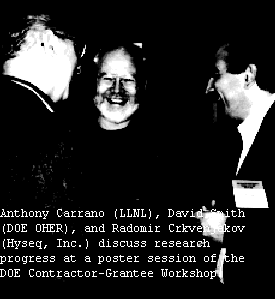Archive Site Provided for Historical Purposes

Sponsored by the U.S. Department of Energy Human Genome Program
Human Genome News, Jan.-Feb. 1995; 6(5): 1
David Smith, Director of the DOE Health Effects and Life Sciences Research Division, observed that the Human Genome Project is ahead of schedule in many areas and increasingly international in scope. He cited achievements in mapping, resource development, instrumentation, and robotics, particularly noting the new maps and the completion of chromosome-specific libraries by the National Laboratory Gene Library Project (NLGLP) at LANL and LLNL.

Anthony Carrano (Lawrence Livermore National Laboratory), David Smith (DOE Office of Health and Envlronmenta/ Research), and Radomir CrkvenJskov (Hyseq, Inc.) discuss research progress at a poster session of the DOE Contractor-Grantee Workshop.
Smith praised establishment in Santa Fe of the National Center for Genome Resources (NCGR), which now houses the Genome Sequence Data Base (GSDB), initially developed at LANL. The new center is poised to become a major distribution source of genome and related information for wider scientific and general use. An important goal is to maintain and improve transparent linkages between sequence data and the mapping data in the Genome Data Base (GDB).
Strategies for placing genes on chromosomal maps are being discussed intensively within the worldwide research community. Such annotation will be important for understanding human biology as well as for eventual commercial applications. While noting that DOE will continue to play an active role, Smith also mentioned the possibility of substantial funding from the private sector.
Technologies arising from the Human Genome Project are enabling others outside the project to make progress in research and development. For example, DOE-supported basic research and technologies are being modified and developed by several companies to make more-rapid diagnostics that may be useful for clinical, agricultural, and environmental applications. Also, investigators have begun sequencing DNA from microbes of industrial, environmental, and phylogenetic interest in the DOE Microbial Genome initiative [see HGN 6(3), 7 (September 1994).]
Smith reminded attendees that, although the project is on time and under budget, the greatest challenge--sequencing the human genome--still lies ahead. DOE and NIH genome program funding is leveling out at $70 million and $110 million, respectively, and the project faces critical challenges in large-scale sequencing. In the next 2 to 3 years, he expects sequencing technology to increase in speed and cost-effectiveness and believes that DOE must shift major resources into high-throughput DNA sequencing. An important milestone in automated large-scale sequencing was reached in 1994 when LBL produced 2 Mb of sequence using a directed strategy.
Smith concluded that the time is right for blending genome technologies into other DOE activities, including the health effects program. This program provides basic understanding of risks associated with exposure to radiation or other environmental agents--part of the original mission that fostered the agency's interest in human genome analysis. DOE will hold several workshops this year to consider how other biology programs and the genome project can share and exploit tools, technologies, and resources developed at universities and the national laboratories.
Denise Casey, HGMIS
Return to DOE Contractor-Grantee Introductory Page
The electronic form of the newsletter may be cited in the following style:
Human Genome Program, U.S. Department of Energy, Human Genome News (v6n5).
The Human Genome Project (HGP) was an international 13-year effort, 1990 to 2003. Primary goals were to discover the complete set of human genes and make them accessible for further biological study, and determine the complete sequence of DNA bases in the human genome. See Timeline for more HGP history.
Published from 1989 until 2002, this newsletter facilitated HGP communication, helped prevent duplication of research effort, and informed persons interested in genome research.